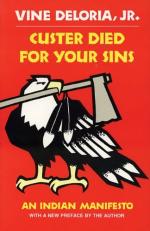
|
| Name: _________________________ | Period: ___________________ |
This test consists of 15 multiple choice questions and 5 short answer questions.
Multiple Choice Questions
1. What was Stewart Udall's explanation about why the Indians had not made progress like his friends in Arizona?
(a) They didn't have the management tools that IBM, General Motors, and Bell Telephone had.
(b) They didn't have the education needed for the task.
(c) They didn't have the right kind of land, like in Arizona.
(d) They didn't have the money of big CEO's at large corporations.
2. Why did the Oglala Sioux become a favorite subject for study by anthropologists?
(a) Because of the art history.
(b) Because of their unique way of life.
(c) Because of the vibrant present.
(d) Because of their romantic past.
3. Once Dillon Myer took over, what was the policy instated from Commissioner to field clerk regarding Indians?
(a) Get their land as quickly as possible.
(b) Get them money as quickly as possible.
(c) Get rid of them as quickly as possible.
(d) Get them health care as quickly as possible.
4. What year did the Congressional policy of termination begin?
(a) 1934.
(b) 1954.
(c) 1880.
(d) 1965.
5. How do most American Indians feels about taxes?
(a) They pay state taxes, but refuse to pay federal taxes.
(b) They feel they paid when they gave up two billion acres of land to the U.S.
(c) They feel they owe taxes.
(d) They feel, like other Americans, that they must pay taxes that are due.
6. What is the oldest Indian treaty between the United States and the Seneca tribe?
(a) The Pickering Treaty.
(b) The Dawes Treaty.
(c) The Church Treaty.
(d) The Allotment Treaty.
7. What happened to most of the treaties in the far west of the country?
(a) The field offices lost the written documents years ago.
(b) The written documents never made it back to Washington.
(c) They were never broken and followed carefully.
(d) They were never ratified by Congress.
8. How many tribal communities get federal services?
(a) 10.
(b) 30.
(c) Hundreds.
(d) Thousands.
9. What did one anthropologist admit spending while studying a tribe of less than a 1,000 people?
(a) Two thousand dollars.
(b) Two hundred dollars.
(c) One hundred and forty thousand dollars.
(d) A million dollars.
10. What was the survey of 1086 called?
(a) The Domesday Survey.
(b) The Century Survey.
(c) The Peasant Survey.
(d) The Middle Ages Survey.
11. What was the decision about the Pottawatomie of Kansas during the time of termination?
(a) To get them better hospitals and roads.
(b) To move them to Missouri.
(c) To combine them with tribes in Oklahoma.
(d) Better to have them expire as private citizens than let anyone know how badly they had been treated.
12. What is the main conflict of the Northwestern tribes and the government?
(a) Hunting and water rights.
(b) Herding rights.
(c) Fishing and Gaming rights.
(d) National Park rights.
13. In the minds of most Indians, what is the best way to eradicate a species?
(a) Let white America care for it.
(b) Put it in the care of the Bureau of Indian Affairs.
(c) Authorize Stewart Udall to conserve it.
(d) Hand it over to the care of the Interior Department.
14. What does not overlap across state boundaries?
(a) Treaty rights.
(b) Water.
(c) Tribes.
(d) Buffalo.
15. What "first" did the Treaty of August 5, 1826 enact?
(a) The first time land was returned to the Indians.
(b) The first time land was sold by the Indians.
(c) The first clear-cut case of fraudulent dealings on part of Congress.
(d) The first time water was sold by the Indians.
Short Answer Questions
1. What kind of people do anthropologists believe the Indians are?
2. How long did the Indians have under the Wheeler-Howard Act to make a decision about their reservation?
3. Who saved the Florida Seminoles from termination?
4. Who was Arthur Watkins?
5. What did early treaties allow the tribes to do to white men violating their laws and borders?
|
This section contains 664 words (approx. 3 pages at 300 words per page) |

|




